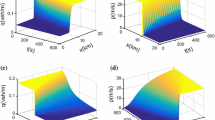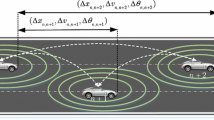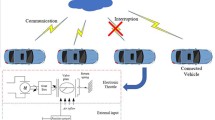Abstract
Due to the continuous development of economy and society, the pace of life is also accelerated, so people pay more and more attention to the time cost, and the transportation time cost is also a very important part of it. The traffic system is an important carrier to realize the traffic operation. The increase of automobile ownership requires the traffic system to be higher and higher. Moreover, vehicles in congested traffic flow inevitably start and stop operations with high frequency, which undoubtedly increases vehicle exhaust emissions, environmental pollution, noise pollution and other problems. For today’s traffic system, vehicle dynamics information is also an important factor which affects the traffic system. Therefore, adding throttle, vehicle dynamics information, to the macro-traffic flow modeling research in this paper is a supplement and improvement to the current traffic flow theory research. By analyzing the equilibrium point, this paper proves the conditions for the existence of Hopf branch and saddle junction branch. Finally, numerical simulation is carried out, and the space–time diagram of density and phase plane are obtained through simulation, which can be used to describe the actual traffic phenomenon. Through numerical simulation, it is found that this model can better describe the congestion phenomenon of the actual traffic system, and provide scientific theoretical support for macroscopic traffic flow state analysis.
Graphical abstract

Establishing macro-traffic flow model considering throttle dynamics











Similar content being viewed by others
Data availability
The manuscript has associated data in a data repository [Authors' comment: In this paper, based on the macroscopic traffic flow model considering throttle dynamics, the equilibrium point and its type of the model are studied by bifurcation analysis method, and the conclusion that the theory is consistent with the simulation is obtained. However, there are many factors that affect the traffic state, which is also the direction of our later research].
References
J.J. Zhang, Y.P. Wang, G.Q. Lu, Impact of heterogeneity of car-following behavior on a rear-end crash risk. Accident Anal. Prev. 125, 275–289 (2019)
Z.H. Yao, T.R. Xu, Y.S. Jiang, R. Hu, Linear stability analysis of heterogeneous traffic flow considering degradations of connected automated vehicles and reaction time. Phys. A Stat. Mech. Appl. 561, 125218 (2021)
Y.F. Jin, J.W. Meng, Dynamical analysis of an optimal velocity model with time-delayed feedback control. Commun. Nonlinear Sci. Numer. Simul. 90, 105333 (2020)
X. Wang, R. Jiang, L. Li, Y.L. Lin, F.Y. Wang, Long memory is important: a test study on deep-learning based car-following model. Phys. A Stat. Mech. Appl. 514, 786–795 (2019)
J. Cattin, L. Leclercq, F. Pereyron, F.E. Faouzi, Calibration of gipps’ car-following model for trucks and the impacts on fuel consumption estimation. IET Intell. Transp. Syst. 13, 367–375 (2019)
Y.Q. Sun, H.X. Ge, R.J. Cheng, An extended car-following model under V2V communication environment and its delayed-feedback control. Phys. A Stat. Mech. Appl. 508, 349–358 (2018)
M.J. Lighthill, G.B. Whitham, On kinematic waves. I. Flood movement in long rivers. Proc. Math. Phys. Eng. Sci. 229, 281–316 (1995)
H.Y. Lu, G.H. Song, L. Yu, The acceleration cliff: an investigation of the possible error source of the VSP distributions generated by Wiedemann car-following model. Transp. Res. D. 65, 161–177 (2018)
X.Y. Wang, Y.Q. Liu, J.Q. Wang, J.L. Zhang, Study on influencing factors selection of driver’s propensity. Phys. A Stat. Mech. Appl. 66, 35–48 (2019)
Z.P. Li, Q.Q. Qin, W.Z. Li, S.Z. Xu, Y.Q. Qian, J. Sun, Stabilization analysis and modified KdV equation of a car-following model with consideration of self-stabilizing control in historical traffic data. Nonlinear Dyn. 91, 1113–1125 (2018)
Y.Y. Qin, H. Wang, Analytical framework of string stability of connected and autonomous platoons with electronic throttle angle feedback. Transportmetrica A 17, 59–80 (2021)
T.Q. Tang, Z.Y. Yi, J. Zhang, T. Wang, J.Q. Leng, A speed guidance strategy for multiple signalized intersections based on car-following model. Phys. A Stat. Mech. Appl. 496, 399–409 (2018)
P. Zhang, Y. Xue, Y.C. Zhang, X. Wang, B.L. Cen, A macroscopic traffic flow model considering the velocity difference between adjacent vehicles on uphill and downhill slopes. Mod. Phys. Lett. B 34, 2050217 (2020)
T.Q. Tang, W.F. Shi, H.J. Huang, W.X. Wu, Z.Q. Song, A route-based traffic flow model accounting for interruption factors. Phys. A Stat. Mech. Appl. 514, 767–785 (2019)
X. Wu, X.M. Zhao, H.S. Song, Q. Xin, S.W. Yu, Effects of the prevision relative velocity on traffic dynamics in the ACC strategy. Phys. A Stat. Mech. Appl. 515, 510–517 (2019)
D. Kawecki, B. Nowack, A proxy-based approach to predict spatially resolved emissions of macro- and microplastic to the environment. Sci. Total Environ. 748, 141137 (2020)
Q.Y. Wang, H.X. Ge, An improved lattice hydrodynamic model accounting for the effect of backward looking and flow integral. Phys. A Stat. Mech. Appl. 513, 438–446 (2019)
C.T. Jiang, R.J. Cheng, H.X. Ge, An improved lattice hydrodynamic model considering the backward looking effect and the traffic interruption probability. Nonlinear Dyn. 91, 777–784 (2018)
C.X. Ma, R.C. He, W. Zhang, Path optimization of taxi carpooling. PLoS ONE 13(8), e0203221 (2018)
C. Samaras, D. Tsokolis, S. Toffolo, G. Magra, L. Ntziachristos, Z. Samaras, Improving fuel consumption and CO2 emissions calculations in urban area by coupling a dynamic micro traffic model with an instantaneous emissions model. Trans. Res. D 65, 772–783 (2018)
D. Guo, J. Wang, J.B. Zhao, A vehicle path planning method based on a dynamic traffic network that considers fuel consumption and emissions. Sci. Total Environ. 663, 935–943 (2019)
T.Q. Tang, Z.Y. Yi, Q.F. Lin, Effects of signal light on the fuel consumption and emissions under car-following model. Phys. A Stat. Mech. Appl. 469, 200–205 (2017)
Y. Igarashi, Quasi-solitons in dissipative systems and exactly solvable lattice models. J. Phys. Soc. Jpn. 68, 791–796 (1999)
M. Bando, K. Hasebe, A. Shibata, Y. Sugiyama, Dynamical model of traffic congestion and numerical simulation. Phys. Rev. E 51, 1035–1042 (1995)
Y.F. Jin, M. Xu, Bifurcation analysis of the full velocity difference model. Chin. Phys. Lett. 27(4), 040501 (2010)
W. Ai, Z. Shi, D. Liu, Bifurcation analysis method of nonlinear traffic phenomena. Int. J. Mod. Phys. C 26, 1550111 (2015)
Yu. Yicai Zhang, P.Z. Xue, D. Fan, H. di He, Bifurcation analysis of traffic flow through an improved car-following model considering the time-delayed velocity difference. Physica A 514, 133–140 (2019)
W. Ren, R. Cheng, H. Ge, Bifurcation analysis of a heterogeneous continuum traffic flow model. Appl. Math. Model. 94, 369–387 (2021)
P. Richards, Shock waves on the highway. Oper. Res. 4(1), 42–51 (1956)
R. Delpiano, J. Laval, J. Coeymans et al., The kinematic wave model with finite decelerations: a social force car-following model approximation. Transp. Res. B Methodol. 71, 182–193 (2015)
R. Jiang, Q. Wu, Z. Zhu, Full velocity difference model for a car-following theory. Phys. Rev. E 64(1), 017101–017105 (2001)
Y. Li, L. Zhang, S. Peeta et al., A car-following model considering the effect of electronic throttle opening angle under connected environment. Nonlinear Dyn. 85(4), 1–11 (2016)
X.P. Meng, L.Y. Yan, Stability analysis in a curved road traffic flow model based on control theory. Asian J. Control. 19, 1844–1853 (2017)
Z.Z. Liu, H.X. Ge, R.J. Cheng, KdV-Burgers equation in the modified continuum model considering the effect of friction and radius on a curved road. Phys. A Stat. Mech. Appl. 503, 1218–1227 (2018)
R. Kaur, S. Sharma, Modeling and simulation of driver’s anticipation effect in a two-lane system on curved road with slope. Phys. A Stat. Mech. Appl. 499, 110–120 (2018)
J. Hedrick, D. Mcmahon, V. Narendran et al., Longitudinal Vehicle Controller Design for IVHS Systems. In American Control Conference (IEEE, 1991), pp. 3107–3112.
K. Li, P. Ioannou, Modeling of traffic flow of automated vehicles. IEEE Trans. Intell. Transp. Syst. 5(2), 99–113 (2004)
P. Ioannou, Z. Xu, Throttle and brake control systems for automatic vehicle following. Inst. Transport. Stud. UC Berkeley 1(4), 345–377 (1994)
S. Jin, D. Wang, P. Tao et al., Non-lane-based full velocity difference car following model. Physica A 389(21), 4654–4662 (2010)
Y. Xue, L. Dong, Y. Yuan et al., Numerical simulation on traffic flow with the consideration of relative velocity. Acta Phys. Sin. 51(3), 495–496 (2002)
Y. Xue, A car-following model with stochastically considering the relative velocity in a traffic flow. Acta Phys. Sin. 52(11), 2750–2756 (2003)
H. Gong, H. Liu, B. Wang, An asymmetric full velocity difference car-following model. Physica A 387(11), 2595–2602 (2008)
H. Ge, R. Cheng, Z. Li, Two velocity difference model for a car following theory. Physica A 387(21), 5239–5245 (2008)
B.S. Kerner, P. Konhäauser, Cluster effect in initially homogeneous traffic flow. Phys. Rev. E 48, 2335–2338 (1993)
J.F. Cao, C.Z. Han, Y.W. Fang, Nonlinear Systems Theory and Application (Xi’an Jiao Tong University Press, Xi’an, 2006)
Y.A. Kuznetsov, Elements of Applied Bifurcation Theory (Springer, New York, 1998), pp.151–194
R. Jiang, Q.S. Wu, Z.J. Zhu, A new continuum model for traffic flow and numerical tests. Transport. Res. B Methodol. 36, 405–419 (2002)
Acknowledgements
The authors would like to thank the anonymous referees and the editor for their valuable opinions. This work is partially supported by the National Natural Science Foundation of China under the Grant Nos. (61863032, 11965019) and the China Postdoctoral Science Foundation Funded Project (Project No.: 2018M633653XB) and the Natural Science Foundation of Gansu Province of China under the Grant No. 20JR5RA533 and the Qizhi Personnel Training Support Project of Lanzhou Institute of Technology (2018QZ-11) and Gansu Province Educational Research Project (Grant No. 2021A-166).
Author information
Authors and Affiliations
Contributions
WHA: Participate in research: propose research topics; Design research scheme; Implement the research process; Final paper. MMW: Article writing: research and collate literature; Design the paper framework; Draft a paper; Revise the thesis; Organize data. DWL: Work support: statistical analysis; Access to research funding; Technical or material support; Instructional support.
Corresponding author
Ethics declarations
Conflict of interest
The authors declared that they have no conflicts of interest to this work. We declare that we do not have any commercial or associative interest that represents a conflict of interest in connection with the work submitted.
Rights and permissions
Springer Nature or its licensor (e.g. a society or other partner) holds exclusive rights to this article under a publishing agreement with the author(s) or other rightsholder(s); author self-archiving of the accepted manuscript version of this article is solely governed by the terms of such publishing agreement and applicable law.
About this article
Cite this article
Ai, W.H., Wang, M.M. & Liu, D.W. Analysis of macroscopic traffic flow model considering throttle dynamics. Eur. Phys. J. B 96, 87 (2023). https://doi.org/10.1140/epjb/s10051-023-00552-9
Received:
Accepted:
Published:
DOI: https://doi.org/10.1140/epjb/s10051-023-00552-9




